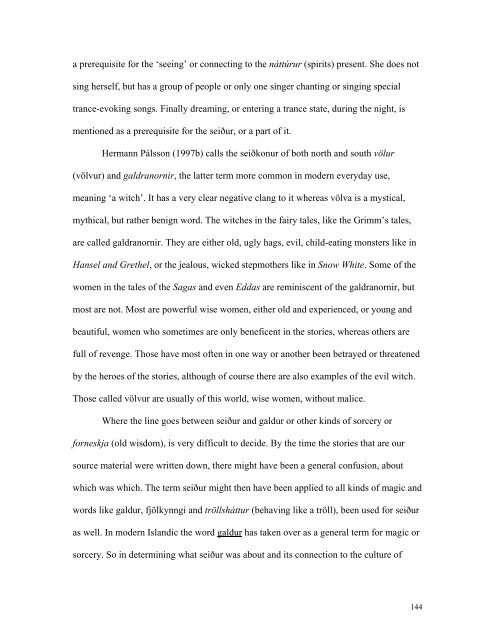Create successful ePaper yourself
Turn your PDF publications into a flip-book with our unique Google optimized e-Paper software.
a prerequisite for the ‘seeing’ or connecting to the náttúrur (spirits) present. She does not<br />
sing herself, but has a group <strong>of</strong> people or only one singer chanting or singing special<br />
trance-evoking songs. Finally dreaming, or entering a trance state, during the night, is<br />
mentioned as a prerequisite for the seiður, or a part <strong>of</strong> it.<br />
Hermann Pálsson (1997b) calls the seiðkonur <strong>of</strong> both north <strong>and</strong> south völur<br />
(völvur) <strong>and</strong> galdranornir, the latter term more common in modern everyday use,<br />
meaning ‘a witch’. It has a very clear negative clang to it whereas völva is a mystical,<br />
mythical, but rather benign word. <strong>The</strong> witches in the fairy tales, like the Grimm’s tales,<br />
are called galdranornir. <strong>The</strong>y are either old, ugly hags, evil, child-eating monsters like in<br />
Hansel <strong>and</strong> Grethel, or the jealous, wicked stepmothers like in Snow White. Some <strong>of</strong> the<br />
women in the tales <strong>of</strong> the <strong>Saga</strong>s <strong>and</strong> even Eddas are reminiscent <strong>of</strong> the galdranornir, but<br />
most are not. Most are powerful wise women, either old <strong>and</strong> experienced, or young <strong>and</strong><br />
beautiful, women who sometimes are only beneficent in the stories, whereas others are<br />
full <strong>of</strong> revenge. Those have most <strong>of</strong>ten in one way or another been betrayed or threatened<br />
by the heroes <strong>of</strong> the stories, although <strong>of</strong> course there are also examples <strong>of</strong> the evil witch.<br />
Those called völvur are usually <strong>of</strong> this world, wise women, without malice.<br />
Where the line goes between seiður <strong>and</strong> galdur or other kinds <strong>of</strong> sorcery or<br />
forneskja (old wisdom), is very difficult to decide. By the time the stories that are our<br />
source material were written down, there might have been a general confusion, about<br />
which was which. <strong>The</strong> term seiður might then have been applied to all kinds <strong>of</strong> magic <strong>and</strong><br />
words like galdur, fjölkynngi <strong>and</strong> tröllsháttur (behaving like a tröll), been used for seiður<br />
as well. In modern Isl<strong>and</strong>ic the word galdur has taken over as a general term for magic or<br />
sorcery. So in determining what seiður was about <strong>and</strong> its connection to the culture <strong>of</strong><br />
144


